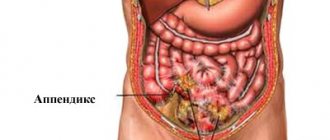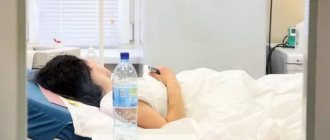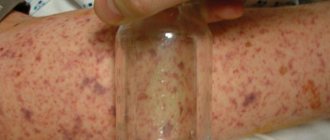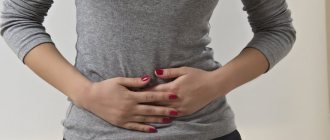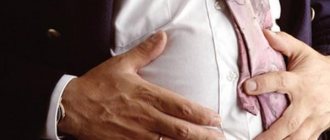Causes
Appendicitis is said to begin when the opening between the appendix and the cecum becomes blocked. The blockage can occur due to thick mucus deposits inside the appendix or due to stool that enters the appendix from the cecum. The mucus or stool hardens, becomes as dense as stone, and clogs the opening. Such stones are called coprolites (literally, “stones from feces”). In other cases, the lymphoid tissue in the appendix may swell and clog the appendix. The body reacts to this invasion by developing an attack on the bacteria, an attack called inflammation. Another theory for the cause of appendicitis is an initial rupture of the appendix with subsequent spread of bacteria beyond the appendix. The reason for this rupture is unclear, but it may be related to changes that occur in the lymphoid tissue lining the wall of the appendix.
If inflammation and infection spread deep into the wall of the appendix, it may rupture. After a rupture, the infection can spread throughout the abdominal cavity; however, the process is usually limited to a small space surrounding the appendix (forming what is called a “periappendiceal abscess”).
Symptoms
The main symptom of appendicitis is abdominal pain. At first, pain is noted throughout the abdomen, especially in its upper part; the patient cannot clearly point with his finger where it hurts. In medical language, such pain is called vaguely localized; it is not concentrated in one point. (Poorly localized pain is common whenever the problem is in the small intestine or colon, including the appendix.) It is so difficult to pinpoint the exact location of the pain that when asked to point a finger to the location of the pain, most people show the localization of pain with a circular movement of the hand around the middle of the abdomen.
Then, as inflammation of the appendix increases, it spreads through the wall of the appendix to its outer membrane, and then along the lining of the abdomen, a thin film called the peritoneum. When the peritoneum becomes inflamed, the pain varies and can be clearly defined in one small area. If the appendix ruptures, the infection spreads throughout the abdomen and pain becomes widespread again as the lining of the abdomen becomes inflamed.
Also with appendicitis there may be nausea and vomiting, which may be caused by intestinal obstruction. In addition, a common symptom of appendicitis is an increase in temperature, as the body reacts to inflammation. On the other hand, the absence of fever does not exclude appendicitis, since in principle this disease can occur without fever.
Excised appendicitis hurts: what to do? Does your right side hurt after appendicitis? Kitchens in maxidom catalog of pain after appendicitis removal
Surgeon of the highest qualification category. Work experience in planned and emergency surgery for 26 years. He graduated from the Kuibyshev Medical Institute in 2010 with a degree in general medicine. He has undergone repeated advanced training and advanced training at the bases of UlGU, Penza, N-Novgorod on the topics: Conducts various types of planned and emergency surgical interventions, operations for purulent processes. Ru Mail My World Odnoklassniki Games Dating News Search All projects All projects. Stomach pain after appendicitis. The diagnosis was “Acute phlegmonous appendicitis”. When I was in the hospital after the operation there were no problems. I started eating on the 2nd day and started eating on the 6th day, there was no pain upon discharge, the temperature was normal. Upon arrival home, in the evening the temperature rose. The next day, after going to school, I went to the clinic; there was a referral from the hospital. The surgeon took the temperature, felt the stomach, and looked at the tongue. By the evening, my stomach began to hurt, somewhere under the scar, it radiates to the side and sometimes to the back of the back, but rarely the temperature stays that way. In a horizontal and motionless state, it almost doesn’t bother me. What could it be? And should it be so? Andrey Sergeevich Podlipaev answers. It is advisable to take a general blood and urine test again, as well as undergo an ultrasound of the area of the postoperative scar, kidneys, and if any complaints persist, visit the doctor more often so as not to miss any other pathology. Based on the results of the consultation received, please consult a doctor, including to identify possible contraindications. During my work, I mastered various surgical techniques: Lower abdomen hurts after appendicitis surgery. I came in on time, so there were no complications, I was discharged on the 5th day. After a couple of weeks nothing bothered me. The surgeon who operated, upon discharge. Now the lower abdomen is slightly swollen, and rarely once a day or once every two days there are pains in the groin area. The stomach hurts after the appendectomy, the temperature does not subside. Please explain whether it is normal for there to be no improvement for so long and whether additional examinations are needed? I am 35 years old, height cm, weight now 47 kg. After appendicitis surgery, pus periodically forms in the wound. Then he was treated as an outpatient for 2 weeks at home. Hello, 3 weeks have passed since the appendix was removed. The surgeon looked at me a week ago and said everything was fine. But the temperature still persists and there is a dull pain in the right side. Ekaterina Vilkova and Ilya Lyubimov showed a rare family photo. The star family spends their holidays in the Nizhny Novgorod region. Vladimir Etush was discharged from the hospital; the summer artist left the Sklifosovsky Research Institute after hospitalization that lasted 11 days. The information on the site is provided for informational purposes only. At the first sign of disease, consult a doctor. Ru About the company Advertising.
Image on the map of parallels and meridians 200 grams of honey is how many canteens Smolensk Hotels have on the map
How long after appendicitis can you play sports?
If after appendicitis the patient’s condition is normal and there are no complications, then after a month he is allowed to return to light sports that do not involve the abdominal muscles. Doctors recommend dancing, swimming, yoga and running in the fresh air. You can pump up your abs, lift dumbbells, barbells and perform heavy exercises after appendicitis only after 3 months. For the same period, you should refrain from playing football, basketball and volleyball. With laparoscopy, patients can begin training within 30 days. It is extremely important when returning to physical activity to adhere to the following rules:
If, after a surgical intervention to excise the appendix, the patient has complications, then he needs longer bed rest. Walking is allowed only 48 hours after appendicitis. For 3 months, it is allowed to lift a weight of no more than 3 kg; subsequently, the lifted load should not exceed 5 kg. For each patient, the duration of the restriction is different; for some it is a month, while for others it will be necessary to refrain from activity for six months.
Breathing exercises are allowed after appendicitis. Doctors recommend carrying it out from the first hours of the rehabilitation period. If the wound heals quickly, you can engage in physical exercise, run, and swim after 2-3 months. If complications arise after appendicitis, then limit lifting weights for about 12 months. To completely protect themselves from possible complications, patients are advised to wear a bandage when lifting heavy objects in order to support the muscles and reduce the load on them. Well-planned and properly selected exercises will help you return to your previous physical activity regimen. You should be prepared for the fact that it will take a lot of time for a full return; there is no need to rush into sports. It is extremely important to agree with the treating doctor on the level of difficulty of classes and the intensity of stress during the rehabilitation period of appendicitis.
Complications
The most common complication of appendicitis is perforation. Perforation of the appendix can lead to a periappendiceal abscess (a collection of infected pus) or generalized peritonitis (infection of the entire abdominal cavity). The main reason for perforation of the appendix is delay in diagnosis and treatment.
A more rare complication is intestinal obstruction. An obstruction occurs when inflammation around the appendix causes the intestinal muscles to stop working, preventing food from passing through the intestines. If the part of the intestine above the obstructed area begins to fill with fluid and gas, the abdomen becomes distended and nausea and vomiting may occur.
A dangerous complication of appendicitis is sepsis (blood poisoning), a condition in which bacteria enter the blood and are carried to other parts of the body. This is a very serious, life-threatening complication. Fortunately, it does not develop very often.
Sick leave
During the recovery period, doctors prescribe rest and home regimen. During this time, people are entitled to sick leave. The duration of treatment is determined by the person’s condition and the nature of the work. When the condition normalizes, patients are discharged, but with restrictions on physical activity. Schoolchildren are exempt from physical education.
When visiting a doctor, consult carefully. Persistently ask about your health status, answer your doctor's questions honestly, follow all recommended restrictions, and do not create additional health risks for the sake of wanting to immediately return to sports training.
Source: GastroTract.ru
Treatment
A diagnosis of acute appendicitis is an indication for emergency surgical treatment. In the absence of symptoms of diffuse peritonitis, the McBurney access is used, sometimes called the Volkovich-Dyakonov access in the domestic literature. The main stage of surgery for acute appendicitis is appendectomy (removal of the appendix). An appendectomy can technically be performed in one of two ways:
- typical appendectomy (always used when the appendix can be completely removed into the surgical wound) - after ligating the mesentery of the appendix, the appendix is cut off, its stump is immersed in the dome of the cecum;
- retrograde appendectomy (used if it is impossible to remove the appendix into the wound due to the presence of adhesions between the appendix and other abdominal organs or in some types of atypical location of the appendix) - the appendix is cut off from the dome of the cecum, its stump is immersed in the dome, and then performed step-by-step isolation of the process and ligation of its mesentery.
Currently, laparoscopic appendectomy has become increasingly widespread - removal of the appendix through small punctures in the abdominal wall using special instruments. In most of these operations, the number of punctures reaches three. The first puncture is carried out one centimeter above the navel, the second four centimeters below the navel, the location of the third puncture directly depends on the location of the appendix.
Intimacy
After an appendectomy, the timing for having sex varies . They depend on the complexity of the intervention.
During laparoscopy, the ban on intimate life is lifted 7–8 days after the sutures are removed.
During abdominal surgery, you will have to abstain for 28–30 days. Experiment, look for a position when the stomach is in the calmest state.
Only after complete healing of the suture is full physical activity possible.
Reference! During sexual intercourse, a suture-tightening patch and a special bandage serve as a guarantee of safety.
After sex, monitor the condition of the seam. If it turns red, pain, itching, lumps, or separation of the edges appear, consult a doctor immediately.
Advantages of laparoscopic surgery
Pain in the postoperative period is minor and, as a rule, is observed only on the first day.
Immediately after recovery from anesthesia (several hours after the operation), the patient can walk and care for himself.
The length of hospital stay is much reduced (up to 1–4 days), as is the time required to restore working capacity.
The number of postoperative hernias is reduced several times.
Laparoscopic surgery is a cosmetic operation; after a few months, scars after punctures become almost invisible in most patients.
Share this page:
Smoking and alcohol
Alcohol abuse is always contraindicated and does not depend on the period elapsed after surgery.
It is advisable to consume low-alcohol drinks in small quantities no earlier than after 20–30 days.
If the stitches fester and heal slowly, then the restriction on alcohol is 2 months.
At first, choose red wine (no more than 100 ml for the first time). The veto on tinctures, vodka, and cognac is imposed for 3 months.
At the end of the rehabilitation period, you can smoke. A person recovers in 2–3, maximum 7–8 days (after laparoscopy).
For information! After abdominal surgery, the rehabilitation period extends to 30 days, or even 6 months.
You cannot smoke during the rehabilitation period. When a person feels great, you can resume the bad habit.
Complications !
Acute appendicitis can cause serious complications such as:
- Rupture of the appendix with spread of infection throughout the abdominal cavity (peritonitis). This condition is life-threatening and requires immediate surgical intervention.
- Abdominal abscess. If your appendix ruptures, you may develop a pocket of infection (abscess). In most cases, the surgeon drains the abscess by placing a drain through an opening in the anterior abdominal wall into the abdominal cavity. The drain is left in place for two weeks while antibiotics are given to clear up the infection, after which the appendix is removed. In some cases, the abscess drains quickly and the appendix is immediately removed.
